Text
Game Concepts
Games can me mind blowing sometimes, right?
I just played one of the really interesting games it's called #Fez

The idea of playing a 2D game in a 3d world is something that got me intrigued!!
Also I tried this game that is called fanart for super mario + portal really 2 different genres mixed together in a way I thought it is not actually used or implemented in a good way game design speaking, but it was fun to try.

I feel like I wanna keep mixing games like that. Right now, I got an idea of creating a mario + portal + fez game for example wouldn't it be fun?
2 notes
·
View notes
Text
A Journey of Creation with Microsoft Designer
Today, I was checking Microsoft Designer. And I wanted to check if I can throw a simple sketch and see if it will create it for me without me going the extra mile and actually learning how to draw.
and here is the results


And then I thought okay that is so good actually let's see if it can turn it to a league of legends character since I like that game.


I do not know where we are heading but this is pretty much awesome isn't it?
0 notes
Text

Just made this T-shirt design. Tell me what you think ♥ 🦅

0 notes
Text

Cloudy Days
1 note
·
View note
Text
Roadmap to Becoming a Game Developer Artist and Designer: Tips for Success
Are you interested in becoming a game developer artist and designer? It's a complex field that requires a diverse set of skills, including programming, design, and art. But don't worry, I've got you covered with this roadmap to help guide you through the process.
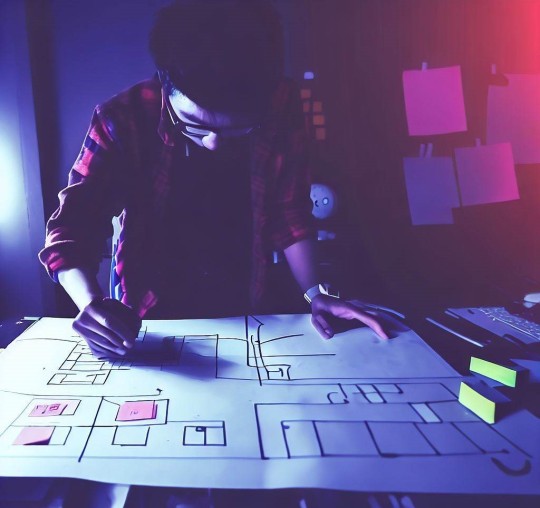
Step 1: Learn the Basics
Before you can become a game developer artist and designer, it's important to have a solid foundation in computer science and art. Here are some resources to help you learn the basics:
Online Courses: Take online courses in computer science and art. Websites like Coursera, edX, and Khan Academy offer free courses in computer science and art fundamentals.
Books: Read books on computer science and art. Some great resources include "Introduction to Computer Science" by David J. Eck and "Drawing on the Right Side of the Brain" by Betty Edwards.
Tutorials: Watch tutorials on YouTube or other online platforms to learn the basics of computer science and art. Some popular channels include The Coding Train and Proko.
Online Communities: Join online communities like Reddit's /r/learnprogramming and /r/learndesign to connect with other learners and ask for advice.
Practice: Practice your skills by completing exercises and projects. Websites like Codecademy and Skillshare offer interactive courses that help you practice your coding and design skills.
Remember, learning the basics is an important first step in becoming a game developer artist and designer. Take your time to build a strong foundation, and don't be afraid to ask for help and seek out additional resources.
Step 2: Choose a Game Engine
Choosing the right game engine is a crucial step in becoming a game developer artist and designer. Here are some resources to help you choose the right game engine:
Online Resources: Research different game engines and compare their features and capabilities. Websites like GameDev.net and Gamasutra offer articles and reviews of popular game engines.
Tutorials: Watch tutorials on YouTube or other online platforms to learn more about different game engines. Some popular channels include Brackeys and Gamefromscratch.
Online Communities: Join online communities like Reddit's /r/gamedev and /r/unity3d to connect with other game developers and ask for advice on choosing a game engine.
Game Engine Websites: Visit the official websites of different game engines to learn more about their features and capabilities. Unity, Unreal Engine, Godot, GameMaker Studio, and Construct all have official websites with documentation and tutorials.
Try Them Out: Download and try out different game engines to see which one you prefer. Many game engines offer free trials or community editions for beginners.
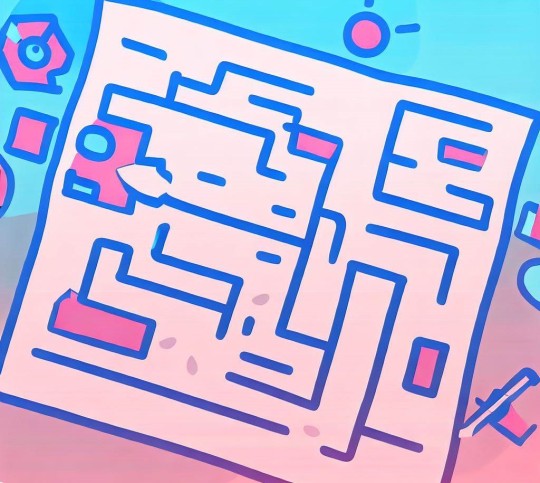
Step 3: Learn Game Development
Learning game development is a crucial step in becoming a game developer artist and designer. Here are some resources to help you learn game development:
Online Courses: Take online courses in game development. Websites like Udemy, Coursera, and edX offer courses in game development for beginners.
Books: Read books on game development. Some popular resources include "The Art of Game Design: A Book of Lenses" by Jesse Schell and "Game Programming Patterns" by Robert Nystrom.
Tutorials: Watch tutorials on YouTube or other online platforms to learn game development. Some popular channels include Blackthornprod and GameDevHQ.
Online Communities: Join online communities like Reddit's /r/gamedev and /r/learnprogramming to connect with other game developers and ask for advice on learning game development.
Game Development Websites: Visit game development websites like Gamasutra and GameDev.net to read articles and tutorials on game development.
Practice: Practice your game development skills by creating small games and projects. Participate in game jams or create personal projects to build your portfolio.
Step 4: Learn Game Design
Game design is a critical aspect of game development that involves creating engaging and fun gameplay experiences for players. Here are some resources to help you learn game design:
Online Courses: Take online courses in game design. Websites like FutureLearn, Pluralsight, and Skillshare offer courses in game design for beginners.
Books: Read books on game design. Some popular resources include "Rules of Play: Game Design Fundamentals" by Katie Salen and Eric Zimmerman and "Level Up! The Guide to Great Video Game Design" by Scott Rogers.
Study Game Design Documents: Analyze game design documents to understand how games are designed. Many game developers publish their design documents online, making it easy to study the design principles behind popular games.
Participate in Game Design Challenges: Participate in game design challenges like the Indie Game Making Contest or the Experimental Gameplay Project. These challenges offer opportunities to practice game design skills and learn from other designers.
Online Communities: Join online communities like the Game Design subreddit or the IGDA Game Design SIG to connect with other game designers and discuss game design topics.
Practice: Practice your game design skills by creating small games and prototypes. Experiment with different mechanics, challenges, and design elements to see what works best.
Step 5: Learn Game Art
Game art is a critical aspect of game development that involves creating visual assets that bring the game to life. Here are some resources to help you learn game art:
Online Courses: Take online courses in game art. Websites like Udemy, Pluralsight, and CG Spectrum offer courses in game art for beginners.
Books: Read books on game art. Some popular resources include "The Fundamentals of Drawing" by Barrington Barber and "Color and Light: A Guide for the Realist Painter" by James Gurney.
Tutorials: Watch tutorials on YouTube or other online platforms to learn game art. Some popular channels include 3DTotal Games and Blender Guru.
Online Communities: Join online communities like the Polycount forum or the Artstation community to connect with other game artists and get feedback on your work.
Practice: Practice your game art skills by creating small game assets and gradually working your way up to more complex projects. Experiment with different art styles, color palettes, and visual storytelling techniques.
Software Tools: Familiarize yourself with software tools commonly used in game art such as Photoshop, 3D Studio Max, Maya, or Blender.
Step 6: Practice, Practice, Practice
The key to becoming a proficient game developer artist and designer is to practice regularly. Here are some tips to help you practice effectively:
Create Small Games: Start by creating small games and gradually work your way up to more complex projects. This will help you build your skills and confidence.
Participate in Game Jams: Participate in game jams like Ludum Dare or Global Game Jam to challenge yourself and practice your skills under pressure.
Create Personal Projects: Create personal projects that interest you and allow you to experiment with different game mechanics and art styles.
Seek Feedback: Share your work with others and seek feedback to improve your skills. Join online communities like Reddit's /r/gamedev or /r/gamedesign to connect with other game developers and get feedback on your work.
Collaborate: Collaborate with other game developers, artists, and designers to learn from each other and create more complex projects.
Remember, practice is essential to becoming a successful game developer artist and designer. The more you practice, the better you will become.
Bonus Step: Network
Networking is important in any field, and game development is no exception. Join online communities like Reddit's /r/gamedev or Discord servers for game developers. Attend game development conferences and events, and connect with other game developers, artists, and designers.
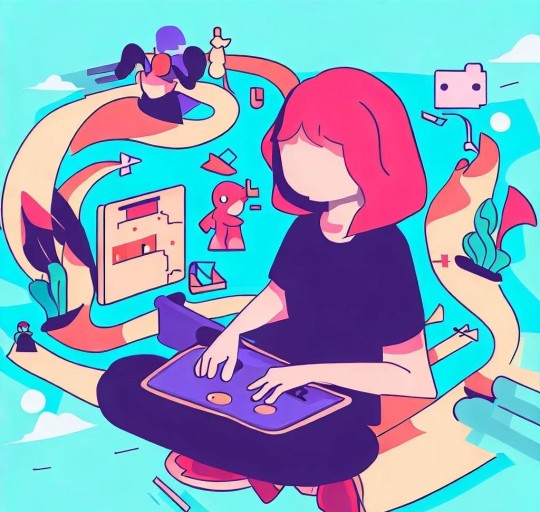
Game development is a constantly evolving field, and it's important to stay up to date with the latest trends and technologies. Here are some additional tips to help you on your journey to becoming a game developer artist and designer:
Stay Current: Subscribe to game development websites and blogs to stay current with the latest news and trends. Some great websites to check out include Gamasutra, GameSpot, and Polygon.
Join Game Development Communities: Join online communities and forums to connect with other game developers, artists, and designers. You can also find valuable resources and get feedback on your work.
Attend Game Development Conferences: Attend game development conferences and events to network with other professionals in the industry and learn about the latest technologies and trends.
Create a Portfolio: Create a portfolio of your work to showcase your skills to potential employers. Include screenshots, videos, and descriptions of your projects.
Apply for Internships: Consider applying for internships or apprenticeships to gain hands-on experience in the industry. This can help you build your resume and make valuable connections.
Keep Learning: Game development is a lifelong learning process. Keep learning and improving your skills by taking courses, attending workshops, and practicing regularly.
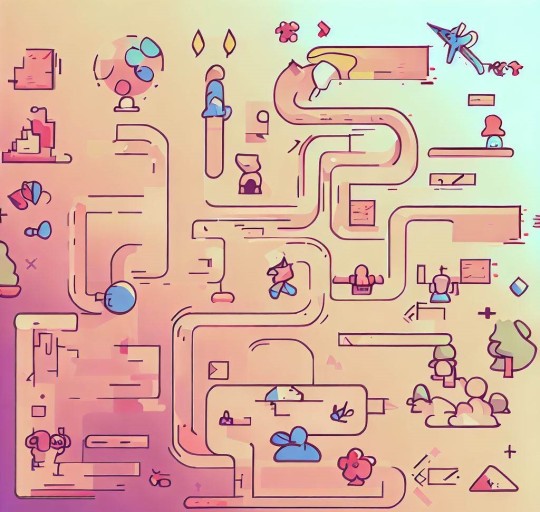
Remember, becoming a game developer artist and designer takes dedication, hard work, and a willingness to learn. Keep practicing and exploring, and you'll be on your way to creating amazing games in no time. Good luck on your journey!
#GameDeveloper#GameDesign#GameArt#GameEngine#GameDevelopment#GamedevCommunity#GameJams#GameDesignChallenges#GameDevelopmentConferences#GamePortfolio#GameInternships#GamingIndustry#GameDevelopmentTips#GameDevelopmentResources#LearningGameDevelopment#GameDevelopmentSkills
2 notes
·
View notes
Text
If they run....
Warwick's claws drip with blood as he surveys the carnage he has wrought. The thugs lay dead, their bodies mutilated beyond recognition. As he stands there, panting and covered in blood, he feels a strange sense of satisfaction. He is the Howling Beast of Zaun, a predator born to hunt and kill.
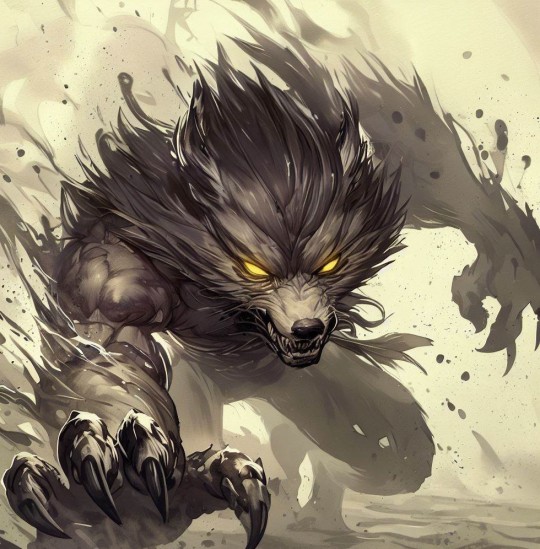
His fur bristles with excitement as he prowls through the dark alleys of Zaun, his eyes glowing with a fierce yellow light. The people of the city know him by reputation - the Howling Beast of Zaun, a creature of darkness and terror that strikes fear into the hearts of all who see him.
As he moves through the shadows, his mind is focused and clear. He is a man of action, a warrior born to fight. But there is something else within him, something that he cannot quite understand. It is the spirit of the ancient ones, the creatures from beyond the veil of reality that he read about in those horror stories.
And then he sees them: a group of people trying to flee down a narrow alley. Warwick snarls, his wolfish instincts taking over. No one runs from him.
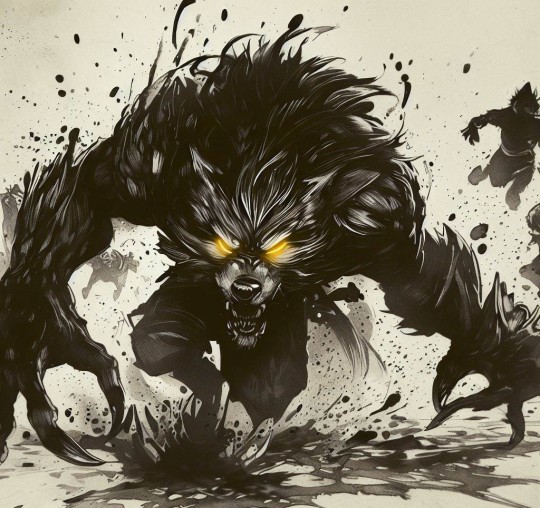
He charges forward, his claws extended like deadly talons. The people try to fight back, but they are no match for his speed and strength. He leaps over one, slashing his claws across the person's back. He lands behind them, spinning around to face the others.
The people circle him, fear in their eyes. Warwick growls, his eyes blazing in a fierce yellow light. He lunges forward, his claws striking out like bolts of lightning.
The first person falls, their throat ripped open by Warwick's claws. The second tries to dodge, but Warwick is too fast. He grabs the person's arm, twisting it until he hears bone snap. The person screams, dropping their weapon.
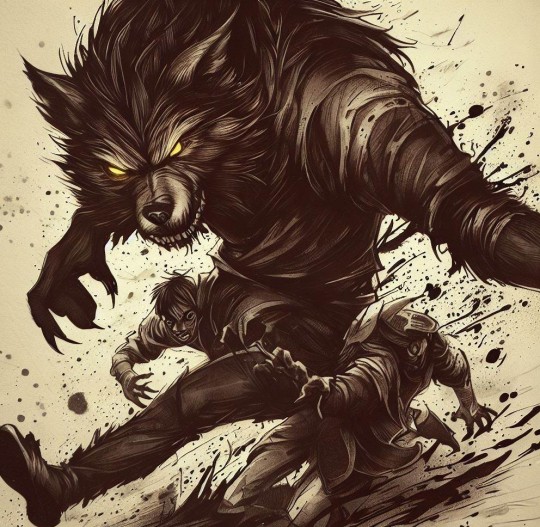
The third person charges forward, swinging a weapon. Warwick ducks under the blow, then lashes out with a kick that sends the person flying into a wall. The person falls to the ground, unconscious.
The fourth and final person hesitates, then turns to run. Warwick snarls, his wolfish instincts taking over. No one runs from him.
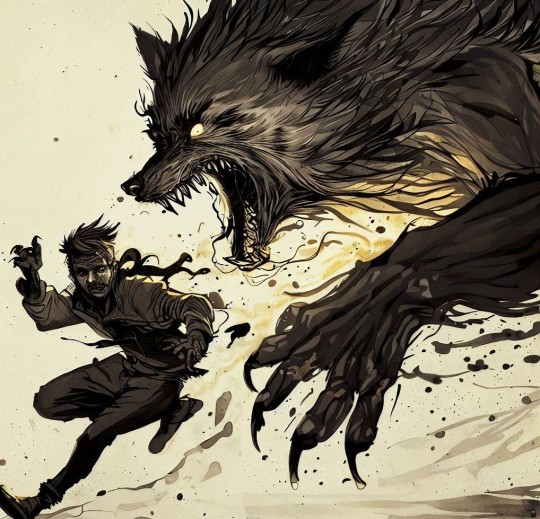
He chases the person down, his claws tearing through the air like a whirlwind of steel. The person trips and falls, and Warwick pounces, pinning them to the ground. The person begs for mercy, but Warwick shows none. He sinks his claws into their chest, ripping out their heart.
As the last person falls, Warwick stands there, panting and covered in blood. He is the Howling Beast of Zaun, a creature born to hunt and kill. And as he looks around at the carnage he has wrought, he knows that he is more than just a man or a wolf.
He is a monster, a creature of darkness and terror that strikes fear into the hearts of all who see him. And as he moves through the dark alleys of Zaun, searching for others to prey upon, he knows that he has finally found his true calling as the horrifying creature of the story.
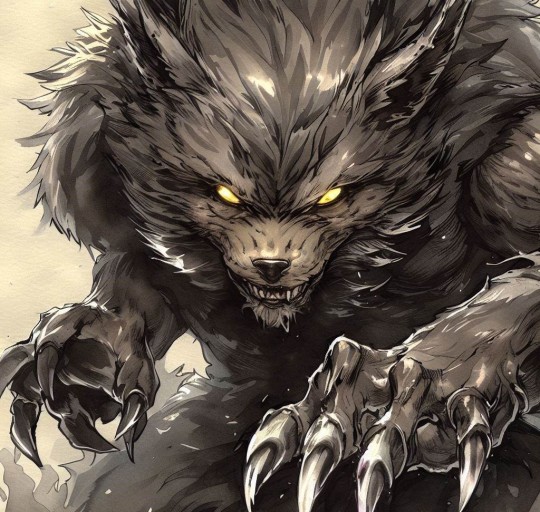
#league of legend art#league of legends#Warwick#story#game design#comics#art#fanart#HowlingBeastOfZaun#monster#horror#darkness#terror#predator#wolf#claws#blood#carnage#fear#ancientones#beyondthereality#predatorandprey#urbanfantasy#Zaun#LeagueofLegends#tumblrfiction#tumblrhorror.#lol
1 note
·
View note
Text
Title: The Rise of AI and the Future of Creativity
It was a warm summer evening and I found myself staring at my computer screen, trying to break through the writer's block that had been hindering my progress for years. That was until I discovered Chat GPT - an AI language model that was changing the game in natural language processing. With Chat GPT, I was finally able to make progress on my project, and it seemed like there was no stopping the rise of AI in everything from programming to writing.
But as I took a break from my work, I started to think about Midjourney - an AI platform that was changing the way artists and creatives worked. With just a few textual prompts, Midjourney was able to generate images and art that looked like they were created by humans. I was amazed, but also a little uneasy. Was this the end of traditional art and creativity?

The rise of AI wasn't just impacting the art world, but also the way we interacted with technology. Voice assistants like Alexa and Siri were becoming more and more common in homes, while Sophia the robot was starting to blur the lines between humans and machines. There were even rumors of people buying human faces to make their robots look more realistic. It was all starting to feel a little too close to "The Terminator" movie.
But then I started to think about something else - the movie "Iron Man." With advances in technology, it was now possible to create exoskeletons that could give people superhuman strength and abilities. It was exciting to think about what the future might hold with these kinds of innovations.
As I finished up my work for the night, I realized that there was no stopping the rise of AI and technology. It was changing the way we lived, worked, and created. But it was up to us to ensure that these advancements were used for good and not to the detriment of humanity. We had to work together with AI and technology to create a better world for everyone.
So, to answer the question of whether or not the "Terminator" movie was real - no, it wasn't. But the rise of AI and technology was very real, and it was up to us to make sure that we used it for good. And who knows, maybe one day we'll be able to become our own version of Iron Man.

0 notes
Text
ِعذبة أنت
ِعَذبةٌ انتِ كماءِ النيلـ
ِو بريئةٌ انتِ كطفلٍ جميلـ
لسانكِ كلحنِ الصباحْـ
و عيناكِ تجعلُ الحلمَ متاحْـ
نسيتُ الهوى إلا هواكـِ
تغلغل في قلبي و اعماقيـ
في دمي انتي كالهواء في صدريـ
و لو اني خبأتكي بقلبيـ
إلى يوم القيامة لن يكفينيـ
حين اتيت لقلبي عاتبتهـُ
للقيايَ به و لحبك احرقتهـُ
قًلتُ له لن ت��تطيع على حبها
فتكلَّم و هجرني في نومي بحُلمِها
انا الليل و انتي القمر
و النجوم حولنا كالممر
فؤادي صاح لي حبيبـ
كملت اوصافه فوجب الترحيبـ
ناعس الطرف كحيل المقلـ
رق في وصفه حلاه الغزلـ
و اشكوا من عذابي في هواكمـ
و اجزيكم عن تعذيبي حب اشواقكمـ
لو يجازى المحب من فرط الشوقـ
لجزيت مثل البحر و ما فوقـ
فُتِنتُ منكِ باوصافٍ مجردة
في القلب لها معانٍ ولا صورة
فلو كان مني اثنانِ لقتلتُ اخيـ
بعذابِ حبكِ و بجمالكِ السخيـ
معاذ أكرم
1 note
·
View note
Text
infinite monkey theorem

states that a monkey hitting keys at random on a typewriter keyboard for an infinite amount of time will almost surely type any given text, such as the complete works of William Shakespeare. In fact, the monkey would almost surely type every possible finite text an infinite number of times. However, the probability that monkeys filling the entire observable universe would type a single complete work, such as Shakespeare's Hamlet, is so tiny that the chance of it occurring during a period of time hundreds of thousands of orders of magnitude longer than the age of the universe is extremely low (but technically not zero). The theorem can be generalized to state that any sequence of events which has a non-zero probability of happening will almost certainly eventually occur, given enough time.
in our case it might have happened if we took a look at the Darwin's theory

0 notes
Text
Scrabble
Originally called Criss Cross, the game, which was based on the crossword puzzle and anagrams, was developed by Alfred M. Butts, an architect, in 1931. It was redesigned, renamed as Scrabble, and marketed by James Brunot in 1948. It was first sold in Great Britain in 1954.
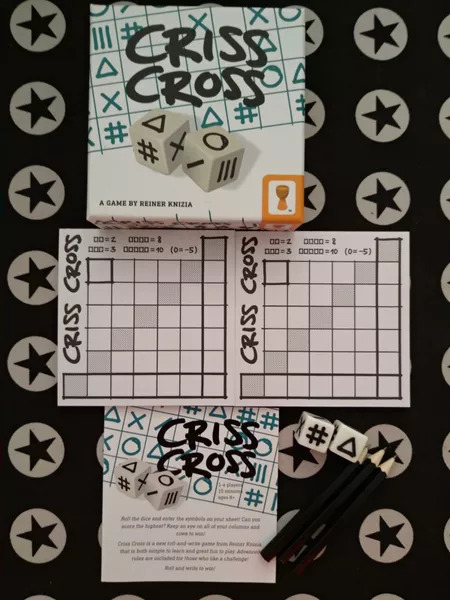
How was it played ?
players have to transfer the symbols rolled to the grid of the block sheet. The more identical symbols are grouped, the more points can be scored. The game is as simple as Sudoku and can also be played alone. > 2 dice are rolled and each player has to draw these symbols into their sheet following very simple rules: - the two symbols have to be drawn in orthogonally adjacent fields. (Single fields previously surrounded with symbols will never be filled.) - as long as there are adjacent spaces, the symbols must be entered. The game ends when the sheets are filled or there are no legal adjacent spaces left. Each row and column are scored separately: 2, 3, 4 or 5 adjacent symbols of the same type score 2, 3, 4, 5 points PLUS 4/5 bonus points for 4/5 symbols.

ok to make it more clearer.
you got 6 symbols on each dice:

you just draw in the sheet the shapes you get after rolling the dice
there is 3 ways you can play this game the simple one the advanced and the solo
If you want to know more just google it.
ok let's take a look on the other thing that scrabble was made on which is anagrams

An anagram is a word or phrase formed by rearranging the letters of a different word or phrase, typically using all the original letters exactly once.
"New York Times" = "monkeys write"
it can be traced back to the time of the ancient Greeks, and were used to find the hidden and mystical meaning in names.
also was used in poetry a lot by the Arabs.
ok back to scrabble!
Scrabble is a word game in which two to four players score points by placing tiles, each bearing a single letter, onto a game board divided into a 15×15 grid of squares. The tiles must form words that, in crossword fashion, read left to right in rows or downward in columns and are included in a standard dictionary or lexicon.

Alfred's decision to make this game was cause of the great depression and his free time but mainly cause of a study he made in his 1931 paper titled "Study of Games" he noted that all popular games of the day were eiher strategy move-based, number or letter games.
he felt that letter games had something to it and after some few years later he finished his prototype of his own letter-based game that he later called 'LEXICO' and didn't even require a board to be played and the letters were drawn on some cardboard squares and had points on them he calculated performing some frequency analysis on the alphabet and had a limited amount of letters but he even gave the 'S' letter only 4 tiles so he limits the use of plurals.
and for more about it I suggest googling or checking YouTube.
it was really nice reading and knowing about the history behind that game.
0 notes
Text
a Bug !

On September 9, 1947, a team of computer scientists reported the world’s first computer bug.
A bug is a flaw or glitch in a system. Thomas Edison reported “bugs” in his designs as early as the 1800s, but this was the first bug identified in a computer. “Debugging” and bug management are important parts of the computer science industry.
This bug, however, was literally a bug. “First actual case of bug being found,” one of the team members wrote in the logbook. The team at Harvard University in Cambridge, Massachusetts, found that their computer, the Mark II, was delivering consistent errors. When they opened the computer’s hardware, they found ... a moth. The trapped insect had disrupted the electronics of the computer.
3 notes
·
View notes
Text
T-Shaped
A T-shaped designer or developer is a specialist who also has a lot of capabilities in other areas. T-shaped devs get their name because the stem (or vertical line) of a T represents their expertise in one area, while the top (or horizontal line) symbolizes their related skills in a broad number of areas. T-shaped designers are great to have on your team, since they come with the benefits of both specialists and generalists. The image below highlights some of the skills a T-shaped UX designer might have. In this example, the person is a visual design specialist but also has knowledge in other areas, like coding and prototyping.

People who are both generalists (highly skilled at a broad set of valuable things — the top of the T) and also experts (among the best in their field within a narrow discipline — the vertical leg of the T). This recipe is important for success at Valve.
"An expert who is too narrow has difficulty collaborating," the handbook states, while "a generalist who doesn't go deep enough in a single area ends up on the margins, not really contributing as an individual."

Valve's new Employee Handbook
0 notes
Text
Feynman Learning Technique
What are the steps of the Feynman Learning Technique?
it is a way of maximizing your learning curve of some topic it goes like this:
Pretend that you are going to teach that topic to a kid
Check with a resource or something if there is any gaps in your explanation method
Reorganize your thoughts and try to say them out loud and if anything went wrong go back to step 2
finally recap and try to explain this topic to someone who doesn't have a clue about the topic and see if they understand it
if that worked then It is guaranteed you understand the topic you are trying to learn I actually did this right now when I read about this topic I wanted to understand it better.


1 note
·
View note
Text
my Summer 💡
I always wanted to plan my day and week and it was always hard to follow a plan but i guess cause of this app it helped me organize my stuff a little better just focused on what i need to learn and how. I liked to share it with you.

I started specifying points I want to make sure I do or don't.

then I started listing the projects I want to work on.
there is a way that I can take notes and attach them to each name as a page and that was a bonus 😂

then made a schedule with every hour still working on it too but i made sure I know it's not a fixed schedule and that I can change anything anytime.

made a section for assignments and exams just so i don't miss any.

then an attendance tracker plus some place to put project ideas also i made a section for making events cause I like to have this day at home or anywhere that i watch or attend things I like to know more about just like normal tech events or concerts but I had this idea back when covid-19 started.
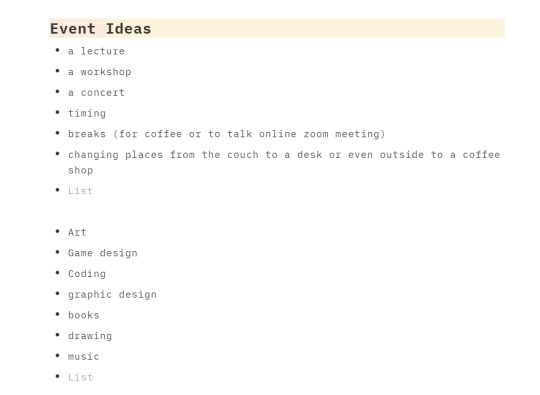
these days you can find everything online that includes talks like ted talks or music concerts so I made this

it was just an idea at first no timing

then I would end it with something musical like this arabian underground band they made a concert that you can watch from home just amazing ... it can also be a stand up comedy the idea is
it is your event your path your WAY !
youtube
and this is my template if you want to copy something from it.
you can also comment on it or here to tell me about any ideas you might think is good to add.
1 note
·
View note
Photo

first day..
3 notes
·
View notes
Text
the butler
this character is about a robot servant that cleans the house it's inspired by a sweeper machine, a fan and mom saying "Do it yourself" <3

0 notes
